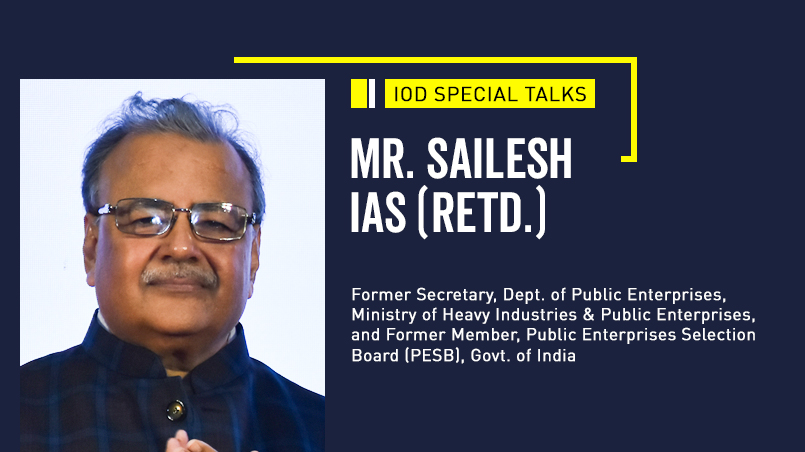 Connect with us
Connect with us

 Aug 05, 2024
Aug 05, 2024
Embracing Management and Change for Sustainable Progress
In terms of the setting of this conference themes on the environment and climate, the words of wisdom, and also the various sessions that have happened during the course of the day, this is my second time being here, and last year I was also here, amongst many of you, and it's great coming back. I will not pick up environment and climate because I think the experts have already spoken in detail, and I'm not an expert in this area. However, I would like to pick up two keywords from the conference, which are 'management' and 'change'. In this setting of management and change, I will briefly discuss a few key happenings both globally and in India that have been responsible for a mega shift or a trajectory of exemplary growth, of which all of you are a major part. Specifically, I would like to mention a few key things about the public sector.
We know that environment and climate are two of the key parameters of sustainable growth for any country, and sustainable growth cannot be possible without absolute growth. Absolute growth will require sustainable livelihoods. What are the key parameters of our growth? We have massive infrastructure spending, we are focusing on manufacturing, improving the service sector, and also agriculture. We have already crossed the threshold to become the fourth largest economy in the world. But the growth in any country will always have competing requirements, and climate and environment has been one of the important factors, which, as rightly said in the morning, when we were growing up were not visible in terms of the attention that we have today. Why? This is largely because of the externalities we have. It is important to everyone, but when it becomes a collective action, then people start thinking in terms of the responsibility of everyone, but not 'me'. We have moved away from this by introducing regulation and creating an architecture of incentives and disincentives.
Every company needs to take a pledge to henceforth not only create value but also create sustainable livelihoods and better governance, and also improve the structures that enable all of us to benefit from growth.
I don't think everyone in the corporate world, whether it is private ownership or public ownership, is trying to maximize shareholder value. Instead, I would say that optimization of value is much more meaningful. Therefore, some growth in value may be compromised to enable us to meet the compliances necessary for the nation and society. Here, the role of climate and environment becomes extremely important.
Last year, the theme was ESG, if I'm not forgetting. I will not be repeating anything I spoke about last year, so I will only refer to additional points this year. Here, I must acknowledge that the regulations in the country, the incentive structure in the country, and also the disincentive structure have been well articulated to take care of a journey where growth is very much there, but it is sustained growth. When we talk of sustainable growth, we do talk of efficiency in each organisation, renewable energy, recycling, and value creation, not only in terms of quantitative indexes but also qualitative parameters. In the qualitative parameters, the most important aspect is that our growth should reach every corner of the country; it should reach all citizens of the country. For that to happen, the generation of wealth in the public and private sectors becomes extremely important. Last year, when I spoke, we had the green shoots of values emerging in the public sector. This year, when I talk about the public sector, we see a dream run in terms of value creation. Has it changed overnight? No, it has not changed overnight. It has been a sustained effort over the last few years. In fact, over the last five to six years, there was a conclave chaired by the Honourable Prime Minister, and every enterprise was given a task to benchmark in terms of global standards.
Of course, the journey has been there. The public sector has embraced the change. They have adopted models of governance that are global in nature and contemporary in terms of competing with the private sector. I will not say that they are truly competing, but they are competing in a very healthy atmosphere. The results, as we all see, are evident. When I was reading a few days ago, if I talk only about the listed public sector companies—about 80 odd companies—the market capitalization of these companies has far exceeded the benchmark indices of both the Nifty and BSE, as well as many other indices. How is that possible?? It is possible because of the increased emphasis on domestic manufacturing and the increased push towards infrastructure. It has been possible because of the governance structure, streamlining of businesses, and improvements in exit models. The changes in company law and solvency procedures are important parameters for easing business and also benefiting consumers. So, value creation is not only beneficial for the government; it is also beneficial for every shareholder.
There is growth in capital expenditure, but there are certain areas of concern as well. Sometimes we see that many companies undergo right-sizing; they evolve in terms of the business plan. When we talk about evolving the business plan, there is a signal effect of the emergence of new opportunities. Recently, there has been talk of artificial intelligence. It has already improved functioning, the way operations are conducted, and the way many tasks are performed. This will happen in a much more robust manner in terms of the data available.
But does it impact people? Does it impact the labour force? We often come across many examples where layoffs occur. One of the primary reasons many companies give for layoffs is that they are necessary because of right-sizing and changing business plans. We recruit more people, sometimes to signal the market. The cost to the company of acquiring new talent is much greater than the cost of opportunity for a person foregoing employment. Therefore, the best course of action will be to reskill the labour force, to sit down, and to evolve business plans.
Business plans don't change overnight, so if emerging opportunities are going elsewhere, how do companies evolve? They evolve over time in terms of standards and requirements. The best way to move forward will be to create value, increase income, and thus increase consumption. That is where the induced growth by CapEx and investment will be much more sustained and selfpropagating, because that is the driving force we are striving for. So every company needs to take a pledge to henceforth not only create value but also create sustainable livelihoods and better governance, and also improve the structures that enable all of us to benefit from growth.
Thank you.

Excerpts from the 'Special Address' delivered by Mr. Sailesh, IAS (Retd.), Former Secretary, Dept. of Public Enterprises, Ministry of Heavy Industries & Public Enterprises, and Former Member, Public Enterprises Selection Board (PESB), Govt. of India, th at the 'Golden Peacock Awards Nite' of the 25 International Conference on Environment Management and Climate Change, held on June 27, 2024 in Hotel The Lalit Ashok, Bengaluru.
Owned by: Institute of Directors, India
Disclaimer: The opinions expressed in the articles/ stories are the personal opinions of the author. IOD/ Editor is not responsible for the accuracy, completeness, suitability, or validity of any information in those articles. The information, facts or opinions expressed in the articles/ speeches do not reflect the views of IOD/ Editor and IOD/ Editor does not assume any responsibility or liability for the same.
About Publisher

Bringing a Silent Revolution through the Boardroom
Institute of Directors (IOD) is an apex national association of Corporate Directors under the India's 'Societies Registration Act XXI of 1860'. Currently it is associated with over 30,000 senior executives from Govt, PSU and Private organizations of India and abroad.
View All BlogsMasterclass for Directors
Categories